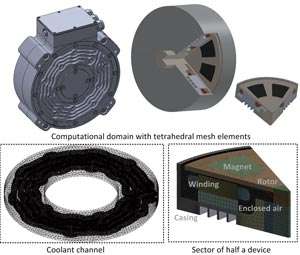A computer representation of the magnet electric electric machines and their components modeled by the numeric algorithm. Credit: Elsevier
An improved method to track and control heat generation in electric motors for cars, or power generators, such as those in wind turbines, has been developed by A*STAR researchers in collaboration with colleagues from the UK.
The scientists devised a numerical model that can predict the thermal properties of these energy conversion machines which includes heat transfer across multiple device components (see image).
For permanent magnet electric machines, a precise knowledge of the temperature distribution is important, as excessively high temperatures can degrade their magnets and electrical windings, and can even lead to a complete failure of the machine.
A detailed understanding of heat creation and distribution is crucial for their design, says Jonathan Hey, from the A*STAR Singapore Institute of Manufacturing Technology (SIMTech) who conducted the study along with colleagues from the Imperial College, London. "These machines are often constructed from an assembly of multiple components, and complex heat transfer mechanisms between the components make it difficult to model the process accurately."
Previous models either have modeled heat conduction within individual components, or studied heat convection on a larger device scale, but failed to consider the specifics of heat transfer across individual component parts.
To solve the issue of simulating the heat transfer between components, the model added a virtual thin material between the simulated parts. A mathematical optimization process was used to determine the thermal properties of the virtual thin material such that it best describes the heat transfer across the interface. Other components of the machines, such as the heat generated by the permanent magnet, are modeled using a similar inverse modeling method.
The computations reveal that the imperfect contacts between components contribute considerably to the thermal properties of the entire machine. However, by including the modeled interfaces into the simulation, and by using experimentally determined parameters, the numerical modeling technique achieves a realistic model of the heat distribution. The model is so accurate that it differs to the measured one by a mere 2.4 per cent.
In future research, the goal is to apply this model to machines of different size and configuration, adds Hey. "Part of the development is to translate the modeling technique into a software tool that can be used by a machine designer. Such a software tool could improve the power density and reliability of next-generation high-performance electric machines." Using these computer models, the software tool could reliably model the properties of a broad range of devices, and therefore help develop prototypes of more efficient energy generation machines.
More information: Jonathan Hey et al. Conjugate heat transfer analysis of an energy conversion device with an updated numerical model obtained through inverse identification, Energy Conversion and Management (2015). DOI: 10.1016/j.enconman.2015.01.065























